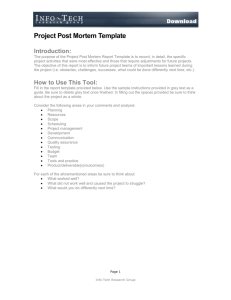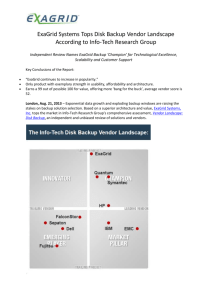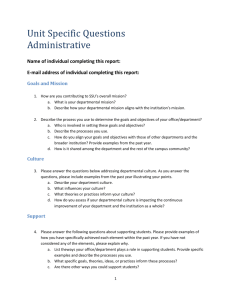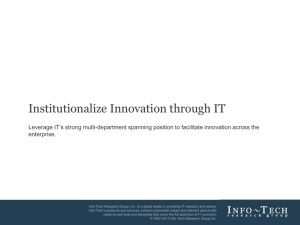Storyboard Template - ITRG - Info
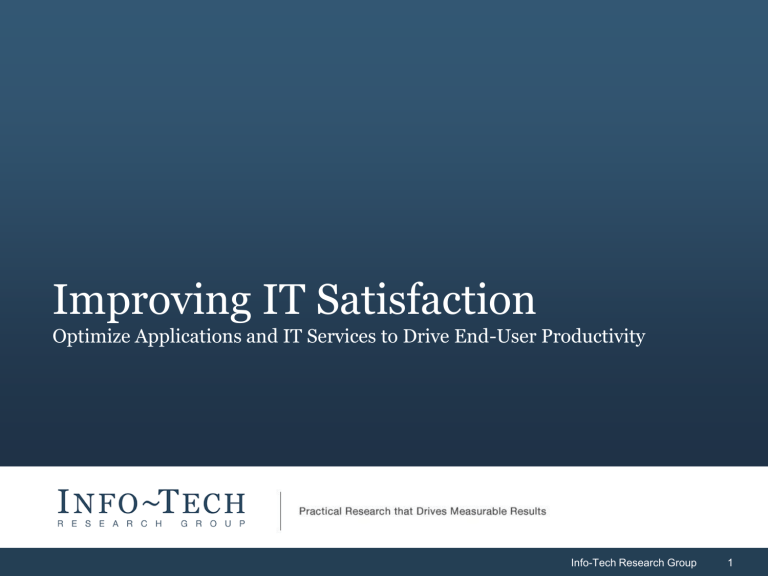
Improving IT Satisfaction
Optimize Applications and IT Services to Drive End-User Productivity
Info-Tech Research Group 1
What’s Next is Up to You
Info-Tech recommends the following communication activities following your completion of the survey.
All activities are optional and should be completed as you see fit.
Info-Tech Research Group 2
Using the Results
General Overview
Scorecard
Bus. Enablement/
IT Communications
Scorecard
IT Services
Scorecard
You get:
•
Overall IT Satisfaction Summary focusing on:
So you can:
•
Identify high-level problem and success business enablement, IT communications, IT services, and suite of applications
•
Overall IT Support Summary
•
Most/least satisfied departments by category areas
•
Benchmark overall improvements year over year
•
Identify most and least satisfied departments
You get:
•
Business Enablement Scorecard capturing: company innovation, IT agility, and department technology enablement
•
IT Communications Scorecard capturing: end-user training, feedback receptivity, and
IT staff professionalism
So you can:
•
Benchmark enduser perception of IT’s role in the business’ success, and IT’s ability to respond to changing business needs
•
Identify training opportunities and ensure professionalism of IT staff
You get:
•
Satisfaction with Core Services
•
Importance Ranking of Core Services
•
Results broken out by seniority, as well as highest and lowest-scoring departments
So you can:
•
Prioritize service optimization initiatives for the coming year
•
Ensure all user groups are satisfied
Info-Tech Research Group 3
Application
Portfolio
Summary
Scorecard
Individual
Application
Scorecards
Department
Satisfaction
Summary
Scorecards
Location-based
Reports
(Optional)
Using the Results
You get:
•
At-a-glance view of application portfolio health from the perspective of end users
•
Breakout of applications that are most critical, most underperforming, and most underused
So you can:
•
Identify opportunities to save on licensing costs, and simplify application management by retiring unwanted applications
•
Focus optimization efforts on applications that are most important to the business
You get:
•
Breakout of satisfaction and importance by department and application
•
Detailed summary of features capability, usability, and data quality cross-referenced by users’ ratings of the application’s importance to their jobs
So you can:
•
Place targeted feedback in the hands of application administrators so they can address shortcomings and increase enduser productivity
•
Ensure each app is valuable and effective for every licensed user group
You get:
• Summary of each department’s satisfaction ratings and comparison to company averages
•
End user comments and suggestions
So you can:
•
Set up feedback sessions with each department to communicate effectively with stakeholders and/or end users, get further feedback, and initiate actionable improvements
You get:
•
Summary of all major categories of data for each location
•
Detailed break out of the top ten most critical applications for each location
So you can:
•
Identify patterns of satisfaction resulting from cultural or infrastructure-based differences among locations
Info-Tech Research Group 4
Step 1. Become the Expert with Info-Tech
Dive into your results package!
Let Info-Tech Guide You.
• Where possible, include key IT decision makers on your results call. Info-Tech will walk you through your results to: o Ensure you understand all facets of the data o Compare your results with those of other organizations o Give you the critical insights needed to enact change o Connect you with targeted research to ensure you see measurable results in next year’s program
Book your Team Review Meeting.
• After your call with Info-Tech, schedule a meeting with your team. In your invite, communicate why you commissioned the reports. Set aside at least half a day (3-4 hours) to go through the results. Plan to go off-site and turn the meeting into an annual experience.
Engage Us!
Get the most out of your data by answering the questions to the right before your results call, and identify three areas of high priority.
Send this to us before your review call to get a tailored analysis.
Before Your Review:
Which departments are most critical to the business?
Which departments are most and least satisfied?
In what mode does IT operate? Firefighter, housekeeper, or innovator?
What is IT’s prioritization of core services? o Does this align with the business’s overall prioritization of core services?
o Does this align with the highest priority departments’ and stakeholders’ prioritization of core services?
What applications need to be addressed now?
What applications are due for re-evaluation or renewal?
In what ways do the reports identify with your expectations and differ from your expectations?
List Top Three Priorities:
1.
…
2.
…
3.
…
Info-Tech Research Group 5
Step 2. Consume Data with Your Team
Structure the Team Review Meeting
Set the Tone
• After your results call with Info-Tech, meet with your team. The objective is not just to share the results of the call with them, but to get them to care about the results.
• Make it explicit that end users are IT’s customers, and customer satisfaction is critical to the success of the IT department and the organization as a whole.
• Satisfying the business’ needs should be presented as a challenge to
IT and can be used as a rallying point.
Review the Data
• Summarize Overall End-User Sentiment. Print out the results (print in color on 11” X 17” for best results). Walk through the overview slides of the report, including locationbased summary (don’t dive into
Individual Application Scorecards or Department Satisfaction
Summary Scorecards). Highlight any problem areas and celebrate any successes.
•
Divide and Conquer. Sort Individual Department Satisfaction
Summary Scorecards into related piles (e.g. by satisfaction rating or importance). Split the team into groups and assign a group to each pile. Ask each group to read through open-ended feedback, summarize three strengths and three weaknesses (or more if desired) of each application. Direct groups not to explain comments, but only to summarize what was said. After 20 minutes of review time, have each group present the results of their review. Repeat this process for
Department Satisfaction Summary Scorecards (optional).
Summarize and Prioritize
• As a group, compile a comprehensive list of Next Steps to address any issues, and use cards or sticky notes to vote on the priority of each step.
Determine Accountabilities
For any high-priority Next Steps, decide what new responsibilities IT staff will have and how future results will impact them.
Goal
…
NEXT STEP
Milestone Date
-- / -- / --
Accountable Party
…
Recommendation
…
Benefits
• …
• …
• …
Actions
1.
…
2.
…
3.
…
Barriers
• …
• …
• …
Info-Tech Research Group 6
Step 3. Build a Communication Plan for the Organization
Communicate to the Business
Brief Stakeholders
• Determine appropriate stakeholders to brief on the results.
Depending on your role and relationship to senior management, this may be the CEO, steering committee, CFO,
COO, CIO, or IT Manager.
• No matter how good or bad the results, they should be used to create commitment to action and improvement. Come prepared with an agenda; initial action plans should benefit as a result of this meeting.
Get Stakeholder Direction on Goals and Objectives
• In most cases, results will support a case to be made for additional resources or significant upgrades in specific services or applications. Use data to discuss potential improvement initiatives and availability of budget. Be prepared to state why you believe a problem exists, how it can be remedied, and the benefits to the business in rectifying this issue.
• Ask stakeholders what they want to see from your initiatives.
This input should develop and improve the initial action plans.
Determine Other Departments and/or Stakeholders to Engage
• Determine which business leaders or user groups should be further engaged to share results and solicit additional feedback.
Agree on Corporate Messaging
• Before formulating any company-wide communications, ensure stakeholders are bought into your plans for sharing the results with the organization, as well as any key user groups.
• Ideally, results should be communicated to all end users who were invited to participate in the survey.
Prepare an Agenda:
Topic: …
Topic Owners: …
Discussion Time: [#] min.
Decision or Required Result: …
Review Date: -- / -- / --
Bring Your Tools:
Info-Tech IT Satisfaction Survey General Overview
Info-Tech Business & IT Communications Overview
Info-Tech Services Overview
Info-Tech Applications Overview
Action Plans (completed)
…
…
Develop Outputs:
Example: CEO Mandate for Improvement Program
Example: Commitment to Increased Budget Flexibility
Example: Communication Plan
…
…
Info-Tech Research Group 7
Step 4. Engage Key User Groups
Initiate and Maintain Engagement
• How you tackle meeting with individual departments will depend on how many there are and which are important to stakeholders.
• However, soliciting feedback and not acting on it is as bad as not soliciting it at all, if not worse. Schedule regular updates with the business to communicate progress.
Process:
Build the End-User Communication Plan
1. Identify and prioritize departments.
• Use the discussion with stakeholders as a starting point.
2. Decide who will be accountable for each department.
• The CIO shouldn’t be responsible for managing more than ten individual business stakeholders, so decide who will.
• For organizations with an unwieldy number of stakeholders, consider using a tier system to group them.
3. Create a plan and regular meeting process.
• To keep end users engaged, the first meeting must be conducted within six months of completing the survey.
• When explaining each department’s results, use the
Department Satisfaction Scorecard to highlight areas with very low scores, very high scores, or significant deviation from the score of the organization average.
• Address neutral or negative feedback with a positive, clientfacing attitude.
• Use the Action Plan templates to develop solutions.
Start with a Plan:
Reiterate the objective of the program: Improving enduser satisfaction and enabling the organization
Highlight success stories
Be transparent about challenges
Explain individual department results
Identify departmental priorities & pain points
Solicit additional department feedback
Share next steps
Bring Your Tools:
Info-Tech Individual Department Scorecard
Summary of Top Three Successes and Pain Paints for this department (from IT Team Review Meeting)
Develop a Timeline for Follow-up
Meetings:
1 st Quarter:
2 nd Quarter:
3 rd Quarter:
4 th Quarter:
Info-Tech Research Group 8
Step 5. Initiate a Service Optimization Initiative
Implement Consistent and Effective IT
Service Capabilities
Identify Service Gaps
When reviewing end-user service satisfaction, the goal should be to have average satisfaction scores above 80% in all areas.
With this in mind, review satisfaction results one service at a time, starting with the highest priority service area.
Prioritize Service Improvement Plans
Select one to three service areas to focus on in the coming year.
Services that are ranked high in importance but low in satisfaction should be addressed first. For example, in the example on the right the network should be a priority, followed by devices.
Identify and Address Unique User Groups
In most cases, addressing an underperforming service that affects everyone is the best option. However, when satisfaction is generally high, look to satisfaction ratings broken out by seniority levels, and by department as, sometimes, specific user groups have needs that differ from the norm.
Some examples of where this might apply include:
• Executives with stringent needs for reporting and analytics
• Designers wanting faster devices or larger monitors
• Researchers asking for relaxed website or video access rights
• Developers relying on faster network capabilities
Need Some Help?
Info-Tech can help you move from ad hoc help to managed services with our five-day workshop!
Info-Tech Research Group 9
Step 6. Rationalize the Application Portfolio
Eliminate Underused Applications
• Today is the right time to consolidate; in the average application portfolio, the number of unneeded applications is on the rise (see below).
• Once the larger IT department has been briefed, assemble the applications team to evaluate the overall health of the application portfolio.
• Print all Specific Application Scorecards and sort according to the quadrant in which each application appears on the
Applications Overview Scorecard (see right).
Source:
Capgemini
Application
Landscape
Report
2014
Info-Tech Research Group 10
Step 6. Rationalize the Application Portfolio
Eliminate Underused Applications
• Applications typically account for approximately 40% of the
IT budget, on average. Identify potential savings in ongoing maintenance costs for non-core applications using data from the end users themselves.
• Start with Nonessential Applications. Labeled Unwanted and Questionable, and viewable on the Applications
Overview page, these applications were rated by end users to be:
• Low in importance (i.e. unused or nice to have)
• Ineffective (low Usability and Features scores)
Feeling Overwhelmed?
Let us guide you through your Application
Rationalization project with our five-day workshop!
Info-Tech Research Group 11
Step 6. Rationalize the Application Portfolio
Eliminate Underused Applications
• Scale Back Licensing.
Review each application’s Scorecard to identify any departments with importance ratings below
50% (“Imp.” on bottom left). In review sessions with these departments, feedback should be solicited around how these applications are utilized to identify opportunities for cutting back licenses.
• Retire Non-Critical Applications. In situations where all departments rate the app as less than 50% in importance, consider retiring the application. However, review responses grouped by seniority and importance rating (right half of the page) to establish exactly how many users view the app as important or critical, and whether those users are satisfied. It may be sufficient to purchase a small set of licenses for the few users that continue to get value from the application.
• Carefully Review Open-Ended Feedback on Each App.
For any departments with low importance ratings for the app, review that department’s comments on the Individual
Application Comments page.
• Confer with internal experts to create an action plan for retirement or de-provisioning of each application that includes input from business owners and IT administrators of each affected application.
Info-Tech Research Group 12
Step 7. Enact an Application Modernization Roadmap
Mitigate At Risk Applications
Develop a strategy for improving overall portfolio satisfaction on an app-by-app basis.
• High risk applications are those that are core to the business, but are underperforming in terms of their effectiveness in enabling the business.
• For each of these applications it is essential to establish a mitigation strategy that targets high-impact problem areas and maximizes IT resources.
• With high risk applications, the focus should not be on importance ratings and cutting back licenses, but instead on satisfaction ratings and improving performance.
Info-Tech Research Group
Source:
Capgemini
Application
Landscape
Report
2014
13
Step 7. Enact an Application Modernization Roadmap
Mitigate At Risk Applications
Dive Deeper with Individual Application Scorecards
The beauty of surveying end users on specific applications is that you get an organization-wide view of each app, including which departments are most or least problematic. For each high risk application look at individual scorecards to determine next steps.
Identify Problem Departments
In many cases, the application may be performing adequately for the core user group for which it was intended (e.g. Sales
Department for CRM). However, users with peripheral use cases may view the application as critical to their role.
Focus first on departments found in the Reassess quadrant; these users are dissatisfied with both Features AND Usability, whereas those in the Upgrade or Retrain quadrants are at least happy with Features or Usability respectively.
Address first any dissatisfied departments that rate this application as important (i.e. Imp. >50%). The goal should be to have all of these departments in the Maintain quadrant.
Summarize the comments listed for dissatisfied departments and, if necessary, schedule focus groups with users to assess functional gaps in the application.
Info-Tech Research Group 14
Step 7. Enact an Application Modernization Plan
Mitigate High Risk Applications
With high risk applications, the Application Manager has three options: Improve user expertise, improve the application itself, or change the app entirely.
The path one takes should depend on answers to this question:
“Does anybody like this app?”
Retrain Users if Super-Users are Happy
Look at satisfaction ratings of end users that indicate the application is Important or Mission Critical to them doing their job.
If they are relatively happy with Features and Usability, these super-users may be leveraged to create a training program for the application to get everyone else up to speed.
Improve Data Input Workflow or Reporting
Data quality scores below 70% indicate that either the workflow of the app is too complex, there are too many fields to enter, the responsiveness of the app is lacking, or the reporting coming out of the app is poor. Upgrading the server or network may help, but poor integration of the application into business process is often the real problem.
Upgrade or Switch Vendors
If all users are dissatisfied, and performance cannot be linked to business process, performance (i.e. infrastructure), or training, the application is in need of an upgrade, or switching vendors is the best alternative.
Tailor Next Steps Using Open-Ended Feedback
Averages lie; carefully evaluate open-ended feedback to color the context around the numbers. Users are typically very forthcoming with invaluable feedback when unhappy.
Info-Tech Research Group 15
Survey End Users
Timeline
Month 1
Results Call with Info-Tech
Consume Data with Your Team
Meet with Critical Stakeholders
Create a Communication Plan
Meet with Individual Departments
Initiate a Service Optimization Initiative
Rationalize the Apps Portfolio
Enact an Application Modernization Plan
Month 3
Six-Month Update to the Business
Month 9
Survey End Users
To Measure Improvements
Quarterly Update to the Business
Month 6
Quarterly Update to the Business
Year 2
Info-Tech Research Group 16
